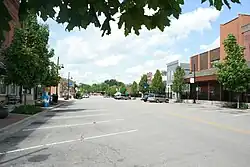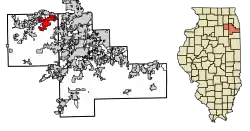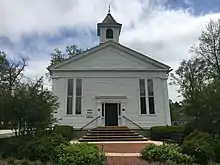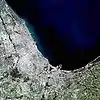Oswego, Illinois
Oswego /ɒsˈwiːɡoʊ/ is a village within the Chicago Metropolitan Area located in Kendall and Will Counties, Illinois, United States. Per the 2020 census, the population was 34,485.[3] Oswego is the largest municipality in Kendall County. It is a suburb/exurb of Chicago, Illinois.[4][5]
Oswego, Illinois | |
|---|---|
 Downtown Oswego | |
 Location of Oswego in Kendall and Will Counties, Illinois | |
.svg.png.webp) Location of Illinois in the United States | |
| Coordinates: 41°41′10″N 88°20′30″W[1] | |
| Country | United States |
| State | Illinois |
| Counties | Kendall, Will |
| Townships | Oswego, Bristol, Wheatland |
| Settled | 1833 |
| Incorporated | 1852 |
| Government | |
| • Village President | Ryan Kauffman |
| Area | |
| • Total | 15.03 sq mi (38.93 km2) |
| • Land | 14.89 sq mi (38.56 km2) |
| • Water | 0.14 sq mi (0.38 km2) |
| Elevation | 659 ft (201 m) |
| Population (2020) | |
| • Total | 34,585 |
| • Density | 2,323.01/sq mi (896.93/km2) |
| Time zone | UTC−6 (CST) |
| • Summer (DST) | UTC−5 (CDT) |
| ZIP code | 60543 |
| Area codes | 630/331 |
| FIPS code | 17-56887 |
| GNIS feature ID | 2399593[1] |
| Website | www |
History

In 1833, William Smith Wilson, his wife Rebecca, and his brother-in-law Daniel Pearce moved to the area now known as Oswego.[6] The land belonged to the local Potawatomi, Ottawa, and Chippewa tribes, but the United States government removed the Native Americans when the government started surveying the land along the Fox River in Kendall County. In 1842, the federal government placed the land for sale at an established price of $1.25 an acre.[7]
After the sale of the land, Lewis Brinsmaid Judson and Levi F. Arnold from New York laid out the village and named it "Hudson". However, when a post office was established, its location was given as "Lodi". Confusion over the official name of the area led to a decision in January 1837, when the citizens gathered and voted "Oswego" as the permanent name of the village by a single vote.[8] The village was named after Oswego, New York, an Iroquois word meaning "mouth of the stream".[9] The ford across the Fox River in the town allowed Oswego to grow economically and as a town, eventually incorporated in 1852 with its village boundaries at the time being Harrison Street to the northwest, Jefferson Street to the northeast, Monroe Street to the southeast, and Benton Street to the southwest.[10] At the advent of the automobile, Oswego continued to see growth as it became a hub for three different state highways (Illinois Route 25, Illinois Route 71, and Illinois Route 31).[6]
Major community developments began when Caterpillar Inc. and Western Electric built industrial plants near Oswego in the mid-1950s.[11] This initially allowed nearby Boulder Hill to develop.[12] The next major development arrived in the mid-1980s during the suburban homebuilding boom, which allowed houses and buildings to populate the village. The rapid growth of the village allowed its limits to expand west of the Fox River into today's boundaries.[6]
Oswego is known to some Chicago-area residents for the town dragstrip on State Route 34, which was open from 1955 until 1979, where muscle cars were raced by drivers from all over the Midwest.[13][14] The drag days are still celebrated even though the strip has been closed for decades.[15] Although evidence of the drag strip, including parts of the track, still remain, the site is off limits to the public.
Geography
Oswego is located in northeastern Kendall County on the Fox River with a small portion in Will County. It is bordered to the north by Boulder Hill and Montgomery, to the east by Aurora, and to the west by Yorkville, the Kendall county seat.
According to the 2010 census, the village of Oswego has a total area of 15.63 square miles (40.5 km2), of which 15.53 square miles (40.2 km2) (or 99.36%) is land and 0.11 square miles (0.28 km2) (or 0.70%) is water.[16]
Downtown
Downtown Oswego is home to historic buildings and homes, as well as shops and restaurants. The Village of Oswego launched a project to enhance and restore the historic downtown district. This project included significant infrastructure and streetscape improvements, such as the installation of brick pavers, sidewalks, landscaping, and decorative streetlights and benches. Hudson Crossing Park, located along the Fox River, opened in October 2004 where many children and families enjoy the scenery. The Waubonsee Creek Promenade, which stretches from Main Street to the new park, is the final phase of the downtown enhancements.[17] In 2008, the village celebrated its 175th anniversary.
Recreation and leisure
The Oswego area is home to over 1,100 acres (450 ha) of open land, trails, and parks maintained by the Oswegoland Park District. Established in 1950, this governmental agency is guided to "create opportunities for a healthy community". Overseeing 63 parks, 16 miles (26 km) of walking trails, two aquatic parks, and the Little White School Museum, the park district provides offerings for the community of 20,000 households as well as visitors from farther away.
The Oswego area holds several races for fitness enthusiasts. Several area festivals are coordinated by the park district, such as the annual PrairieFest.[18]
Demographics
| Census | Pop. | Note | %± |
|---|---|---|---|
| 1880 | 663 | — | |
| 1890 | 641 | −3.3% | |
| 1900 | 618 | −3.6% | |
| 1910 | 600 | −2.9% | |
| 1920 | 676 | 12.7% | |
| 1930 | 932 | 37.9% | |
| 1940 | 978 | 4.9% | |
| 1950 | 1,220 | 24.7% | |
| 1960 | 1,510 | 23.8% | |
| 1970 | 1,862 | 23.3% | |
| 1980 | 3,021 | 62.2% | |
| 1990 | 3,876 | 28.3% | |
| 2000 | 13,326 | 243.8% | |
| 2010 | 30,355 | 127.8% | |
| 2020 | 34,585 | 13.9% | |
| U.S. Decennial Census[19] 2010[20] 2020[21] | |||
2020 census
| Race / Ethnicity | Pop 2010[20] | Pop 2020[21] | % 2010 | % 2020 |
|---|---|---|---|---|
| White alone (NH) | 23,700 | 23,400 | 78.08% | 67.66% |
| Black or African American alone (NH) | 1,518 | 2,574 | 5.00% | 7.44% |
| Native American or Alaska Native alone (NH) | 26 | 30 | 0.09% | 0.09% |
| Asian alone (NH) | 1,022 | 1,588 | 3.37% | 4.59% |
| Pacific Islander alone (NH) | 9 | 7 | 0.03% | 0.02% |
| Some Other Race alone (NH) | 45 | 153 | 0.15% | 0.44% |
| Mixed Race/Multi-Racial (NH) | 479 | 1,417 | 1.58% | 4.10% |
| Hispanic or Latino (any race) | 3,556 | 5,416 | 11.71% | 15.66% |
| Total | 30,335 | 34,585 | 100.00% | 100.00% |
Note: the US Census treats Hispanic/Latino as an ethnic category. This table excludes Latinos from the racial categories and assigns them to a separate category. Hispanics/Latinos can be of any race.
2019 American Community Survey
As of the census[22] of 2019, there were 36,252 people, 11,215 families living in the village. The population density was 2,025/mi2 (782/km2). There were 10,388 housing units at an urban density of 668.9/mi2 (258.3/km2). The racial makeup of the village was 82.0% White, 5.6% African American, 0.24% Native American, 4.79% Asian, 0.03% Pacific Islander, 3.24% from other races, and 2.24% from two or more races. 17.1% of the population were Hispanic or Latino of any race.
There were 9,935 households, out of which 50.3% had children under the age of 18 living with them, 69.2% were married couples living together, 10.58% had a female householder with no husband present, and 19.2% were non-families.[23] The average household size was 3.08 and the average family size was 3.43.[22]
In the village, the population was spread out, with 34.7% under the age of 20, 17.0% from 20 to 34, 33.2% from 35 to 54, 8.3% from 55 to 64, and 6.8% who were 65 years of age or older. The median age was 33.9 years.[22]
As of the 2019 census, the median income for a household in the village was $117,624, and the median income for a family was $102,110. Males had a median income of $75,849 versus $56,164 for females. The per capita income for the village was $37,839. 1.49% of the population and 1% of families were below the poverty line. Out of the total population, 1.49% of those under the age of 18 and 1.56% of those 65 and older were living below the poverty line.[22]
Education
The Oswego Community Unit School District 308 serves Oswego, Boulder Hill, Montgomery, Plainfield, Aurora, Yorkville and Joliet. It operates 22 schools, including one early learning center, 14 elementary schools for grades K-5, 5 junior high schools for grades 6-8, 2 high schools, and one opportunity school.[24] Portions of Oswego are within Yorkville Community Unit School District 115, which operates Yorkville High School.[25]
Notable people
- Rob Baxley, former professional football player[26]
- Arthur M. Beaupre, diplomat; born in Oswego[27]
- Tom Cross, former member of the Illinois House of Representatives[28]
- Slade Cutter, former naval officer and member of the College Football Hall of Fame[29]
- Rita B. Garman, former Chief Justice of the Supreme Court of Illinois[30]
- Joey Goodspeed, former professional football player; running back for the Minnesota Vikings, St. Louis Rams, and San Diego Chargers[31]
- John Hamilton, member of the John Dillinger gang who was buried near here in summer of 1934[32]
- J. Dennis Hastert, former Congressman and Speaker of the United States House of Representatives (1999–2007),[33] convicted child molester[34]
- AJ Johnson, professional bowler on the PBA Tour
- Alex Magee, former professional football player; defensive end for the Kansas City Chiefs and Tampa Bay Buccaneers[35]
- Robert Mitchler, Illinois state senator[36]
- Robinson B. Murphy, Civil War Army musician; Medal of Honor recipient[37]
- Maud N. Peffers, Illinois state representative[38]
- Tom Sharpe, drummer for Mannheim Steamroller as well as Dennis DeYoung[39]
- Julianne Sitch, former professional soccer player. First woman to ever win an NCAA championship as coach of a men’s team
- Keith R. Wheeler, member of the Illinois General Assembly[40]
Awards and recognition
Oswego was ranked #58 in 2011 on CNN/Money Magazine’s Top 100 Best Towns to live.[41] CNN Money ranks these towns based on their job opportunities, schools, safety, economic strength, and other qualities. Kendall County has continuously been ranked as one of the fastest-growing counties and a place of rapid job growth.[42]
Gallery
 Village hall
Village hall Old fire department
Old fire department Veteran's Memorial Plaza
Veteran's Memorial Plaza Hudson Crossing Park
Hudson Crossing Park Downtown during PrairieFest parade
Downtown during PrairieFest parade
References
- U.S. Geological Survey Geographic Names Information System: Oswego, Illinois
- "2020 U.S. Gazetteer Files". United States Census Bureau. Retrieved March 15, 2022.
- "Oswego village, Illinois". United States Census Bureau. Retrieved April 15, 2022.
- "Living in Oswego". Niche. Retrieved 2022-12-01.
- "Could new Metra service to Kendall County enable a fantastical journey to Oswego? - Streetsblog Chicago". chi.streetsblog.org. 2021-04-06. Retrieved 2023-07-31.
- "History". OswegoIL.org. Archived from the original on 20 December 2014. Retrieved 15 December 2014.
- Matile, Roger (April 30, 2008). "2". Oswego Township. Arcadia Publishing. p. 23. ISBN 978-0738552088.
- Matile, Roger (April 30, 2008). Oswego Township. Arcadia Publishing. p. 7. ISBN 978-0738552088.
- "About Us". oswegotownship.org. Retrieved 12 March 2023.
- "Archived copy" (PDF). Archived (PDF) from the original on 2016-12-25. Retrieved 2017-02-02.
{{cite web}}: CS1 maint: archived copy as title (link) - Roger, Matile (2008). Oswego Township. Charleston, SC: Arcadia Pub. p. 8. ISBN 978-0738552088.
- Dardick, Hal (January 2, 1991). "Boulder Hill has it all but a town that it can call its own". Chicago Tribune. Chicago Tribune. Archived from the original on 13 August 2016. Retrieved 28 June 2016.
- Alaimo, Salvatore (August 24, 2011). "Oswego Dragstrip in Oswego, Illinois Holds Many Drag Racing Memories". Dragzine. Power Automedia. Archived from the original on 14 September 2016. Retrieved 28 June 2016.
- Lohnes, Brian (July 27, 2011). "Wednesday Time Killer: Awesome Photos and History From Oswego Dragway, Including Grumpy Jenkins Wreckage!". BangShift.com. Archived from the original on 10 August 2016. Retrieved 28 June 2016.
- Antinori, Shannon (July 14, 2014). "New Museum Exhibit Highlights Oswego Drag Raceway". Oswego Patch. Patch Media. Archived from the original on 4 August 2016. Retrieved 28 June 2016.
- "2010 Census U.S. Gazetteer Files for Places – Illinois". United States Census. Archived from the original on 2012-08-10. Retrieved 2012-10-13.
- Brack-Johnson, Ann (November 24, 1998). "Oswego Looks Creekward". Chicago Tribune. Chicago Tribune. Archived from the original on 13 August 2016. Retrieved 28 June 2016.
- http://www.oswegolandparkdistrict.org.aspx
- "Decennial Census of Population and Housing by Decades". US Census Bureau.
- "P2 HISPANIC OR LATINO, AND NOT HISPANIC OR LATINO BY RACE – 2010: DEC Redistricting Data (PL 94-171) – Oswego village, Illinois". United States Census Bureau.
- "P2 HISPANIC OR LATINO, AND NOT HISPANIC OR LATINO BY RACE – 2020: DEC Redistricting Data (PL 94-171) – Oswego village, Illinois". United States Census Bureau.
- "U.S. Census website". United States Census Bureau. Archived from the original on 1996-12-27. Retrieved 2016-06-27.
- "U.S. Census Bureau QuickFacts: Oswego village, Illinois". U.S. Census. U.S. Census Bureau. Archived (PDF) from the original on 16 September 2016. Retrieved 19 December 2016.
- "District Building Information". Community Unit School District 308. Archived from the original on 2013-05-22. Retrieved 2013-04-17.
- "About Our School District" (Archive). Yorkville Community Unit School District 115. Retrieved on June 9, 2015.
- "Rob Baxley". profootballarchives.com. Archived from the original on March 4, 2016. Retrieved June 27, 2016.
- Newton Bateman, Paul Selby, Historical Encyclopedia of Illinois, Volume 2, 1904, page 739
- "Former State GOP Leader Tom Cross Has Painful Connection To Hastert Case". WBBM-TV. April 27, 2016. Retrieved February 4, 2021.
- "Slade Cutter". National Football Foundation. Retrieved February 4, 2021.
- "Rita B. Garman, Supreme Court Chief Justice: Fourth District". IllinoisCourts.gov. Archived from the original on June 26, 2016. Retrieved June 27, 2016.
- "Joey Goodspeed". Scout. Scout.com. Archived from the original on 10 April 2016. Retrieved 28 June 2016.
- Newton, M. (2002). The Encyclopedia of Robberies, Heists, and Capers. Checkmark Books, an imprint of Facts on File, Inc. ISBN 0-8160-4489-9. pp. 128-129.
- "HASTERT, John Dennis". History, Art, and Archives. United States House of Representatives. Archived from the original on 16 August 2016. Retrieved 28 June 2016.
- Jason Meisner, Jeff Coen & Christy Gutowski, Dennis Hastert, former U.S. House speaker, sentenced to 15 months in prison, Chicago Tribune (April 27, 2016).
- "Alex Magee". NFL. NFL Enterprises LLC. Archived from the original on 17 August 2016. Retrieved 28 June 2016.
- 'Illinois Blue Book 1979-1980,' Biographical Sketch of Robert Mitchler, pg. 144
- "Musician Robinson B. Murphy, Civil War Medal of Honor Recipient".
- 'Illinois Blue Book 1955-1956,' Biographical Sketch of Maud N. Peffers, pg. 228-229
- Gire, Dann (24 February 2015). "Mannheim Steamroller drummer from Oswego writes symphony". Archived from the original on 28 February 2018. Retrieved 30 January 2020.
- "Representative Keith R. Wheeler (R)". Illinois General Assembly. Retrieved February 4, 2021.
- "Money Magazine "Best Places to Live 2011"". BestPlaces.net. Archived from the original on 15 January 2015. Retrieved 15 December 2014.
- Christie, Les (16 June 2010). "Fastest growing counties in the U.S." Archived from the original on 1 December 2014. Retrieved 15 December 2014.
External links
 Media related to Oswego, Illinois at Wikimedia Commons
Media related to Oswego, Illinois at Wikimedia Commons- Official website
